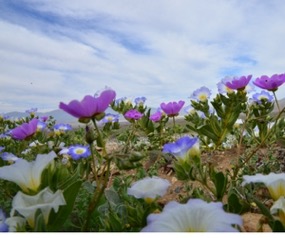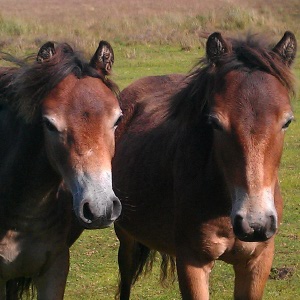Amazingly Brilliant, Bach Flower Remedies for Animals

What are Bach Flower Remedies?
Dr Edward Bach (1886-1936) trained as a doctor in the 1910's and went on to develop this branch of homeopathy during the 1920's-1930's. There are 38 different remedies. Some are made from flowers, whilst others are made from the flowers of trees, bushes and plants with water. The Bach system of flower remedies is different to other flower essence systems that exist. Each may have their own benefits, but the Bach Flower Remedy system is distinct from others.
You may've already heard of Rescue Remedy? This is a combination of Bach Flower Remedies and is designed to help with situations that generate fear or shock.
Why Can Bach Flower Remedies Be Useful for Your Animals?
Dr Bach saw his therapy would benefit all living creatures and therefore the therapy is used both for humans and animals. Many animals can benefit - including horses, cats, dogs, birds and other pets or livestock.
Flower remedies work by affecting the emotions and may help in many ways, including:
- Assisting with learning;
- Fears and anxieties;
- Recuperation from illness;
- Aiding in learning and cognitive skills;
- Rehabilitation of traumatised animals
Bach Flower Remedies will probably be useful to help your animal at some point during his or her life. They can be used to help with all types of emotional states, so have a role to play in assisting with many scenarios. This could be at particularly stressful times, e.g.:
- Going to the Veterinary Surgeon
- Christmas
- Other times of noisy celebration
- Competitions/shows
- Learning something new, the right remedy can help your dog or horse (or other animal) feel less overwhelmed or excited in his or her training sessions
- Or when your animal has other health or wellbeing issues.
But as with all complementary therapies please remember to contact your Veterinary Surgeon for advice before using. In addition when dealing with a behavioural issue - please remember that no remedy can replace correct, patient and gentle training. Instead Bach Flower Remedies can be used to support behavioural change.
Read more about the benefits of these individual Bach Flower Remedies in my blog:
Here's an example of 4 of the 38 different flower remedies and their benefits:
Aspen – for fear of the unknown (ideal if your animal gets nervous in new places such as a show);
Chestnut Bud – to support learning;
Rock Rose - for terror and fear (e.g. calm from thunderstorms or firework noise)
Walnut – to help cope with change (eg ownership/environment/travelling).
How Long Before The Flower Remedies Will Work?
If the right remedies have been selected and properly administered, positive results are usually seen within two to three weeks, if not sooner than that. As with any therapy/treatment, results depend on the individual animal. In a "crisis situation" the right remedy can make a difference within minutes or hours. Which is what often happens with Rescue Remedy.
How To Administer Flower Remedies to Animals
The remedies are used by giving 3 or 4 drops to the animal - either in drinking water or by putting drops on your hand and letting the animal lick them off. They can be used in combination and repeated 2-4 times daily until a change is noted or the stressful situation has passed, (if it is particularly stressed, the remedies maybe administered more frequently). In addition you can add the remedies to snacks or training rewards (eg. biscuit), to assist with your animals learning.
For safety do not administer drops direct from the dropper into an animal’s mouth - as the dropper tube is made of thin glass and could be extremely harmful if bitten off and swallowed. [Please ignore some videos that you may see online, which show differently - it is dangerous!!]
Different Bach Flower Remedies Include:
Agrimony; Aspen Beech; Centaury; Cerato; Cherry Plum; Chestnut Bud; Chicory; Clematis; Crab Apple; Elm; Gentian; Gorse; Heather; Holly; Honeysuckle; Hornbeam; Impatiens; Larch; Mimulus; Mustard; Oak; Olive; Pine; Red Chestnut; Rescue Remedy; Rock Rose; Rock Water; Scleranthus; Star of Bethlehem; Sweet Chestnut; Vervain; Vine; Walnut; Water Violet; White Chestnut; Wild Oat; Wild Rose; Willow.
Like to Learn More About Bach Flower Remedies for Animals?
The Bach Centre approves several providers of courses around the world. The introductory level 1 course is also available via distance learning from The Bach Centre.
You can learn specifically how to use Bach Flower Remedies to help animals. Complete the specialist level 3 programme on the care of animals. This is run by the Natural Animal Centre in Wales. As a level 3 programme though, it is only open to people who've already completed levels 1 and 2 Bach Centre approved education.
See more on why should use Bach Flower Remedies for natural care of your animal, and see my blog post for more insight
Would you like information on Bach Flower Remedy Practitioners near you for your animal? Please email me at info@taranet.co.uk, I'll be pleased to try and assist!
You can get more information on many complementary therapies for animals here at Taranet. Take a look at the sitemap here for a list.
About The Author
This article has been extensively researched and written by Suzanne Harris. Who is also the designer and developer of this site. A lifelong animal lover with a passion for ensuring animals can access complementary therapies for their health and wellbeing.
